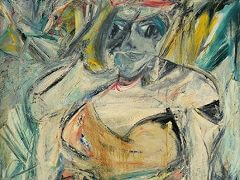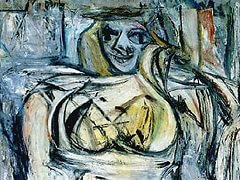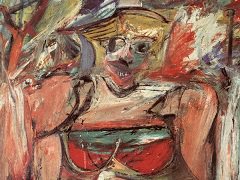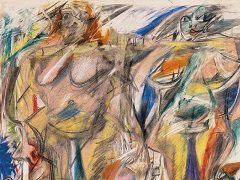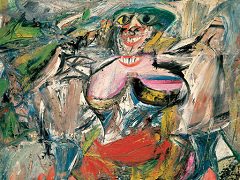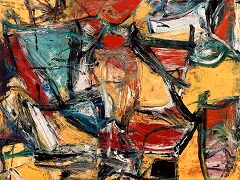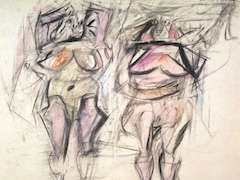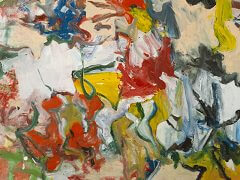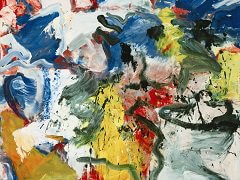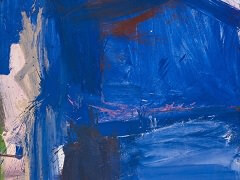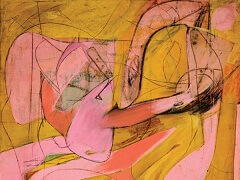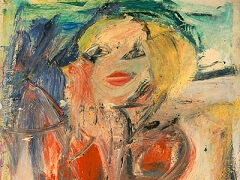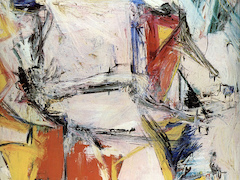The Renaissance and Order by Willem de Kooning
In the Renaissance, when people - outside of being hung or crucified - couldn't die in the sky yet, the ideas a painter had always took place on earth. He had this large marvelous floor that he worked on. So if blood was on a sword, it was no accident. It meant that someone was dying or dead.
It was up to the artist to measure out the exact space for that person to die in or be dead already. The exactness of the space was determined or rather, inspired by whatever reason the person was dying or being killed for. The space thus measured out on the original plane of the canvas surface became a 'place' somewhere on that floor. If he were a good painter, he did not make the center of the end of that floor - the vanishing point on the horizon - the 'content' (as the philosophers and educators of commercial art want to convince us nowadays that they did). The 'content' was his way of making the happening on the floor measurable from as many angles as possible instead. The main interest was how deep the happening - and the floor itself - could be or ought to be. The concept he had about the so-called 'subject' established the depth; with that he eventually found how high it was and how wide. It was not the other way around. He wasn't Alice looking into the Looking Glass. The scene wasn't there yet. He still had to make it.
Perspective, then, to a competent painter, did not mean an illusionary trick. It wasn't as if he were standing in front of his canvas and needed to imagine how deep the world could be. The world was deep already. As a matter-of-fact, it was depth which made it possible for the world to be there altogether. He wasn't so abstract as to take the hypotenuse of a two-dimensional universe. Painting was more intellectual than that. It was more intriguing to imagine himself busy on that floor of his - to be, so to speak, on the inside of his picture. He took it for granted that he could only measure things subjectively, and it was logical therefore that the best way was from the inside. It was the only way he could eventually project all the happenings on the frontmost plane. He became, in a way, the idea, the center, and the vanishing point himself - and all at the same time. He shifted, pushed, and arranged things in accordance with the way he felt about them. Sure they were not all the same to him. His idea of balance was a 'wrought' one or a 'woven' one. He loved something in one corner as much as he hated something in another. But he never became the things himself, as is usually said since Freud. If he wanted to, he could become one or two sometimes, but he was the one that made the decision. As long as he kept the original idea in mind, he could both invent the phenomena and inspect them critically at the same time. Michelangelo invented Adam that way, and even God.
In those days, you were subjective to yourself, not to somebody else. If the artist was painting St. Sebastian, he knew very well he wasn't St. Sebastian - nor was he one of the torturers. He didn't understand the other fellow's face because he was painting his own: he understood it better because he himself had a face. He could never become completely detached. He could not get man out of his mind.
There must be something about us, he thought, that determines us to have a face, legs and arms, a belly, nose, eyes and mouth. He didn't even mind that people were flesh-colored. Flesh was very important to a painter then. Both the church and the state recognized it. The interest in the difference of textures - between silk, wood, velvet, glass, marble - was there only in relation to flesh. Flesh was the reason why oil painting was invented. Never before in history had it taken such a place in painting. For the Egyptians, it was something that didn't last long enough; for the Greeks, it - and everything else - took on the texture of painted marble and plaster walls. But for the Renaissance artist, flesh was the stuff people were made of. It was because of man, and not in spite of him, that painting was considered an art.
Art was also tied up with effort. Man, and all the things around him, and all that possibly could happen to him - either going to heaven or hell - were not there because the artist was interested in designing. On the contrary, he was designing because all those things and himself too were in this world already. That was his great wonder. The marvel wasn't just what he made himself, but what was there already. He knew there was something more remarkable than his own ability. He wasn't continuously occupied with the petulant possibilities of what 'mankind' ought to do. If they were beating something, it wasn't their own breasts all the time. You can see for yourself that he was completely astonished. Never a pose was taken. Everything was gesture. Everything in these paintings 'behaved.' The people were doing something; they looked, they talked to one another, they listened to one another, they buried someone, crucified someone else. The more painting developed, in that time, the more it started shaking with excitement. And very soon they saw that they needed thousands and thousands of brush-strokes for that - as you can see for yourself in Venetian painting.
The drawing started to tremble because it wanted to go places. The artist was too perplexed to be sure of himself. How do we know, he thought, that everything is really not still, and only starts moving when we begin to look at it? Actually there was no 'subject-matter.' What we call subject-matter now, was then painting itself. Subject matter came later on when parts of those works were taken out arbitrarily, when a man for no reason is sitting, standing or lying down. He became a bather; she became a bather; she was reclining; he just stood there looking ahead. That is when the posing in painting began. When a man has no other meaning than that he is sitting, he is a poseur. That's what happened when the burghers got hold of art, and got hold of man, too, for that matter. For really, when you think of all the life and death problems in the art of the Renaissance, who cares if a Chevalier is laughing or that a young girl has a red blouse on.
It seems that so far, I have a chip on my shoulder. If I brought up Renaissance painting, it is not out of regret or because I think that we lost something. I do feel rather horrified when I hear people talk about Renaissance painting as if it were some kind of buck-eye painting good only for kitchen calendars. I did it also because it is impossible for me ever to come to the point. But when I think of painting today, I find myself always thinking of that part which is connected with the Renaissance. It is the vulgarity and fleshy part of it which seems to make it particularly Western. Well, you could say, "Why should it be Western?" Well, I'm not saying it should.
But, it is because of Western civilization that we can travel now all over the world and I, myself, am completely grateful for being able to sit in this ever-moving observation car, able to look in so many directions. But I also want to know where I'm going. I don't know exactly where it is, but I have my own track. I'm not always sure I'm on it, but sometimes I think I am.
In a recent issue of Life magazine (the half-century number), it is the pages on art which made it obvious that we are in the right direction. Everything else is dated. I mean this of course in relation to what was presented in that issue. Different directions in art were presented but, for my part, I picked Marcel Duchamp.
There is a train track in the history of art that goes way back to Mesopotamia. It skips the whole Orient, the Mayas [sic] and American Indians. Duchamp is on it. Cézanne is on it. Picasso and the Cubists are on it; Giacometti, Mondrian and so many, many more - whole civilizations. Like I say, it goes way in and back to Mesopotamia for maybe 5,000 years, so there is no sense in calling out names. The reason I mention Duchamp is because he was one of the artists in Life's half-century number. But I have some feeling about all these people - millions of them - on this enormous track, way into history. They had a peculiar way of measuring. They seemed to measure with a length similar to their own height. For that reason they could imagine themselves in almost any proportions. That is why I think Giacometti's figures are like real people. The idea that the thing that the artist is making can come to know for itself, how high it is, how wide and how deep it is, is a historical one - a traditional one I think. It comes from man's own image.
I admit I know little of Oriental art. But that is because I cannot find in it what I am looking for, or what I am talking about. To me the Oriental idea of beauty is that "it isn't here." It is in a state of not being here. It is absent. That is why it is so good. It is the same thing I don't like in Suprematism, Purism and non-objectivity.
And, although I, myself, don't care for all the pots and pans in the paintings of the burghers - the genre scenes of goodly living which developed into the kind sun of Impressionism later on - I do like the idea that they - the pots and pans, I mean - are always in relation to man. They have no soul of their own, like they seem to have in the Orient. For us, they have no character; we can do anything we please with them. There is this perpetual irritability. Nature, then, is just nature. I admit I am very impressed with it.
The attitude that nature is chaotic and that the artist puts order into it, is a very absurd point of view, I think. All that we can hope for is to put some order into ourselves. When a man ploughs his field at the right time, it means just that.
Insofar as we understand the universe - if it can be understood - our doings must have some desire for order in them; but from the point of view of the universe, they must be very grotesque. As a matter-of-fact, the idea of 'order' reminds me of something Jack Tworkov was telling me that he remembered of his childhood.
There was the village idiot. His name was Plank and he measured everything. He measured roads, toads, and his own feet; fences, his nose and windows, trees, saw and caterpillars. Everything was there already to be measured by him. Because he was an idiot, it is difficult to think in terms of how happy he was. Jack says he walked around with a very satisfied expression on his face. He had no nostalgia, neither a memory nor a sense of time. All that he noticed about himself was that his length changed!

